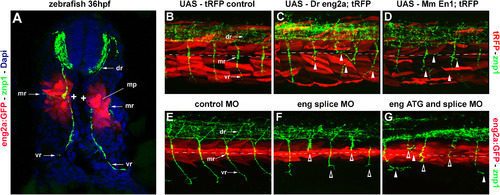- Title
-
Engrailed controls epaxial-hypaxial muscle innervation and the establishment of vertebrate three-dimensional mobility
- Authors
- Ahmed, M.U., Maurya, A.K., Cheng, L., Jorge, E.C., Schubert, F.R., Maire, P., Basson, M.A., Ingham, P.W., Dietrich, S.
- Source
- Full text @ Dev. Biol.
|
Gain and loss of zebrafish eng function causes complementary innervation phenotypes. (A) Cross section of a 36hpf zebrafish eng2a:GFP embryo (transgene expression shown in red); axons were stained with the znp1 antibody (green) and cell nuclei with Dapi (blue). Initially, the primary motor neurons all projected to the eng expressing muscle pioneers (mp, strong staining) and the accompanying fast muscle cells> (weaker staining), which together subdivide the myotome into an epaxial and hypaxial portion at the position marked by (+) and organise the formation of the horizontal myoseptum. At the stage shown, the secondary motor neurons have also formed. Neurons aligned with the caudal somite half have extended their axons ventrally to form the ventral ramus and innervate the hypaxial myotome. Motor neurons next to the rostral somite half send their axons laterally along the developing horizontal myoseptum to form the medial ramus and target the superficial slow muscles. Motor neurons facing the rostrocaudal centre of each segment project dorsally to form the dorsal ramus and innervate the epaxial myotome; they eventually withdraw their connection to the eng+ cells. Abbreviations: dr, dorsal ramus; mp, muscle pioneers; mr, medial ramus; vr, ventral ramus; Dr, Danio rerio; Mm, Mus musculus. (B-G) Lateral views of 36hpf control (B,E) and experimental (C,D,F,G) embryos, anterior to the left. The position of the developing horizontal myoseptum is indicated by a stippled line. (B-D) Gain-of-function experiments: transgenic α actin-Gal4 embryos injected with (B) a UAS-tRFP control construct, (C) a bicistronic UAS- driven construct expressing tRFP and zebrafish eng2a, or (D) a bicistronic construct expressing tRFP and mouse En1 as indicated at the top of the panel. Cells that have taken up the constructs fluoresce in red (anti-tRFP); axons are revealed with the znp1 antibody in green. When Engrailed genes were misexpressed throughout the somite, motor axons were severely misguided (C,D, arrowheads). (E-G) Loss-of-function experiments: eng2a:GFP embryos (transgene expression shown in red, znp1-stained axons in green) treated with (E) a control morpholino, (F) a morpholino cocktail targeting the splice sites of all eng genes expressed in the somite, or (G) a morpholino cocktail targeting the eng1a,b,2aATG and the splice sites. Knock down of eng blocked axonal outgrowth, and axons stalled or took up erratic paths in search for their targets (F,G, open arrowheads). |

ZFIN is incorporating published figure images and captions as part of an ongoing project. Figures from some publications have not yet been curated, or are not available for display because of copyright restrictions. PHENOTYPE:
|
Reprinted from Developmental Biology, 430(1), Ahmed, M.U., Maurya, A.K., Cheng, L., Jorge, E.C., Schubert, F.R., Maire, P., Basson, M.A., Ingham, P.W., Dietrich, S., Engrailed controls epaxial-hypaxial muscle innervation and the establishment of vertebrate three-dimensional mobility, 90-104, Copyright (2017) with permission from Elsevier. Full text @ Dev. Biol.

